|
|
Central American Cichlids
|
By Neale Monks |
Central American cichlids are adaptable, often quite aggressive fish
that require moderately hard and alkaline water conditions. They are
among the most popular cichlids in the hobby thanks to their bright
colours and general hardiness, but the large size of some species and
their sometimes violent behaviour means that few are suitable for the
average community tank.
Environment
Limestone dominates much of the geology of Central American, and
consequently the rivers and lakes tend to be hard and alkaline. Volcanic
crater lakes are a distinctive feature of the Central American aquatic
environment, characterised by their rocky banks and great depth. Lake
Nicaragua is a particularly famous example, and besides being home to a
variety of cichlids, bull sharks regularly swim into the lake from the
Pacific Ocean via the 120-mile San Juan River.
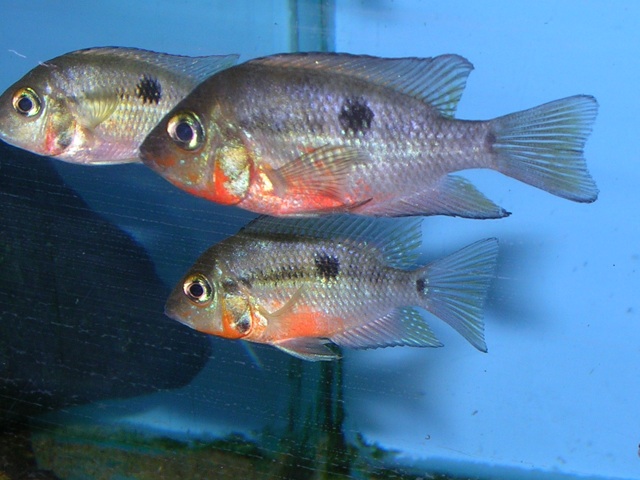
“The Firemouth cichlid Thorichthys
meeki is a native to Mexico, Guatemala and Belize.”
Some Central American cichlids come from fast-flowing streams and
rivers. These are known as rheophilic species and in captivity are
particularly sensitive to poor quality water and low oxygen
concentrations. As well as freshwater habitats, many Central American
cichlids are found in brackish water environments, and a few are even
found in the sea, albeit close to the shore in mangroves, lagoons and
bays.
Central American cichlids occupy a variety of niches, ranging in size
from small species that fed on insect larvae through to very large
predators sitting at the top of the food chain. One of the biggest
cichlids known to science is from Central America, the 70 cm (27.5
inches) fish-eating cichlid Parachromis dovii. Big specimens
can weigh as much as 6.8 kg (about 15 lb). It is one of a variety of
big, carnivorous cichlids known in Central America as guapote,
a word that can be translated as ‘most handsome’.
Water chemistry
If you live in a hard water area, the chances are your tap water will be
adequate for keeping these fish. Central American cichlids are adaptable
and do well across a range of water chemistry values, though as ever in
fishkeeping, it is important to maintain pH and hardness stability
between water changes. In general, pH 7-8 and a hardness of 10 degrees
dH or more will suit these fish well.
In soft water areas some hardening of the water will be necessary. One
approach is to place calcareous media (such as crushed coral) in one of
the compartments inside a canister filter. As the water flows past this
media it will dissolve some of the calcium carbonate, resulting in
harder, more alkaline water. Because filters get dirty over time, any
such media will gradually lose its buffering capacity as it gets covered
with dirt and slime. To prevent problems, take care to clean any
calcareous media under a hot tap at least once a month, or sooner if you
find the pH dropping.
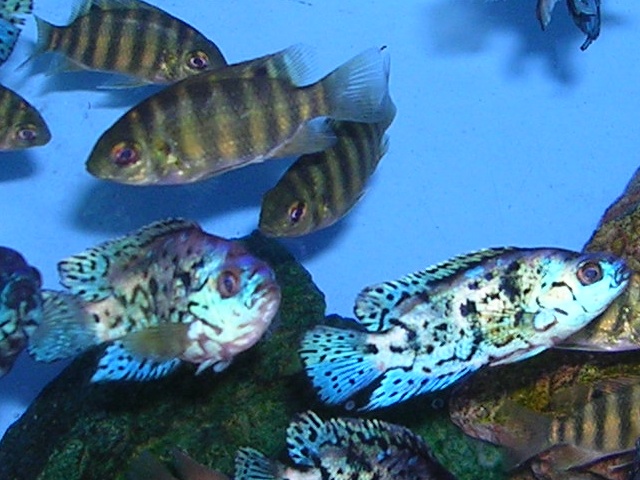
“Electric Blue Jack Dempsey cichlids are typical of Central Americans in
preferred moderately hard, alkaline water conditions.”
An alternative approach is to add minerals to each bucket of new water.
You can use commercially available cichlid salts of the type produced
for Malawian and Tanganyikan cichlids, but you likely won’t need to use
the full dose. A half dose should be adequate, though check the pH and
hardness with your test kits and adjust as required. If you want to make
your own mineral salts, then add 1 teaspoon baking soda (sodium
bicarbonate), 1 tablespoon Epsom salt (magnesium sulfate), and 1
teaspoon marine salt mix (sodium chloride and various trace elements)
per 10 gallons (40 litres) of water. Again, check the pH and hardness
and adjust as necessary.
Salinity
Some Central American cichlids inhabit brackish water habitats and could
be kept in a brackish water system. One benefit of keeping these fish in
brackish water conditions is that the marine salt mix will automatically
adjust pH and hardness to appropriate levels.
Examples of species found in slightly brackish water include
Amphilophus hogaboomorum, Herichthys carpintis,
Herichthys pearsei, Parachromis friedrichsthalii,
Parachromis motaguensis, Rocio octofasciata and Vieja
synspila. These will do well at specific gravity levels up to
around SG 1.005. A few species are able to live and breed in fully
marine conditions. These include Cichlasoma urophthalmus,
Nandopsis haitiensis, Nandopsis tetracanthus and Vieja
maculicauda.
None of these fish needs brackish water conditions to do well, and all
could be kept in a plain freshwater aquarium without problems.
Water temperature
For most species the usual 25 degrees C (77 degrees F) will suffice.
Higher temperatures are sometimes advocated by hobbyists, but the only
real benefit of this is to increase the frequency with which these
cichlids spawn. Unless you are farming these fish on a massive scale,
there’s no particular reason to have your fish spawning every 3-4 weeks!
Diet
Gut contents of wild fish tend to show a mix of organic detritus, algae,
plant material, benthic invertebrates and sometimes small fish. The
ratios vary from species to species, but it is obvious that these fish
naturally have a varied diet. Under aquarium conditions most specimens
tend to be highly adaptable, with things like cichlids pellets,
tinned/cooked peas, and frozen invertebrates such as bloodworms all
being readily consumed.
Vitamin deficiency is at least one factor behind the dreaded
Hexamita infections that cause Hole-in-the-Head disease, and with
the omnivorous and herbivorous species especially, it is important to
provide them with a regular supply of green foods including
Spirulina flake, tinned peas, spinach, blanched curly lettuce,
sushi nori, and even cheap aquatic plants (Elodea is ideal).
The predatory species will happily take small fish, but a live fish diet
cannot be recommended. Goldfish and rosy-red minnows in particular are
unhealthy because of their high fat and thiaminase content, and the
cheap fish sold in pet stores are riddled with parasites and pathogenic
bacteria. It isn’t even necessary to give these fish a live food diet
anyway, as they will just as readily take chunky seafood, lancefish and
cichlid pellets.
Decorating the tank
Since most Central American cichlids come from shady habitats with lots
of cover, they appreciate a tank that isn’t too brightly lit. Most
species like to dig, so live plants, except perhaps floating species,
aren’t of much use. Instead concentrate on large plastic plants, rocks,
and pieces of artificial or real bogwood. Because large amounts of
bogwood can acidify the aquarium over time, if you decide to use a lot
of this material, monitor pH carefully and do not neglect water changes!
The sand-sifting species will appreciate a fine substrate. River sand is
ideal, but otherwise a mix of four parts smooth silica sand to one part
coral sand will produce a reasonable facsimile. Because these
cichlids like subdued light and shady environments, they don’t
appreciate brightly coloured gravels.
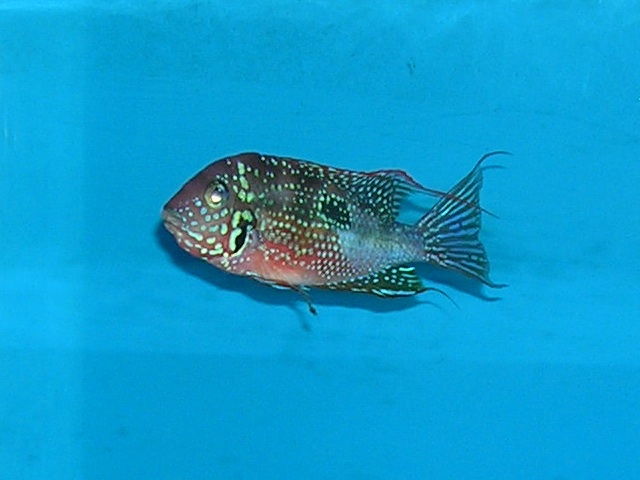
“Thorichthys ellioti is adapted to sifting food particles from
sand, much like the South American eartheaters”
Because these fish dig a lot, take care that their activity cannot
undermine your arrangement of rocks. Make sure all rocks are securely
balanced, and if necessary use a gravel tidy to secure a cushioning
layer of gravel at the bottom of the tank. This will prevent any rocks
slipping and cracking the glass.
Most of these fish spawn in caves, or at least dig a pit somewhere
sheltered. In many cases a flowerpot on its side makes an ideal nesting
site.
Social behaviour
All Central American cichlids are territorial, and often aggressively so
when spawning. Very few make good community fish. The mildest species
are the Firemouth cichlid Thorichthys meeki and the Rainbow
cichlid Archocentrus multispinosus, and to lesser degrees the
T-bar cichlid Cryptoheros sajica and the Jade-eye cichlid
Cryptoheros spilurus.
Most of the other Central Americans are sufficiently aggressive that
they are best kept either in matched pairs in their own tanks or as
singletons in large communities alongside suitably robust cichlids.
Unless you want to breed these cichlids, don’t bother keeping pairs or
groups. Most species display a high degree of intraspecific aggression,
and even within pairs, the males can sometimes be extremely nasty
towards unresponsive females, even killing them.
Central American cichlids can be kept with schooling dither fish, at
least in the case of the less aggressive, non-piscivorous species.
Large, fast-moving tetras from Central America would be particularly
appropriate, for example the Mexican tetra Astyanax mexicanus,
but you could equally easily used Australian rainbowfish or some of the
larger Asian barbs.
Catfish are often kept with Central American cichlids. Robust members of
the Loricariidae such as Hypostomus, Pterygoplichthys
and Panaque are particularly useful. Since they hide most of
the time, they generally avoid serious trouble.
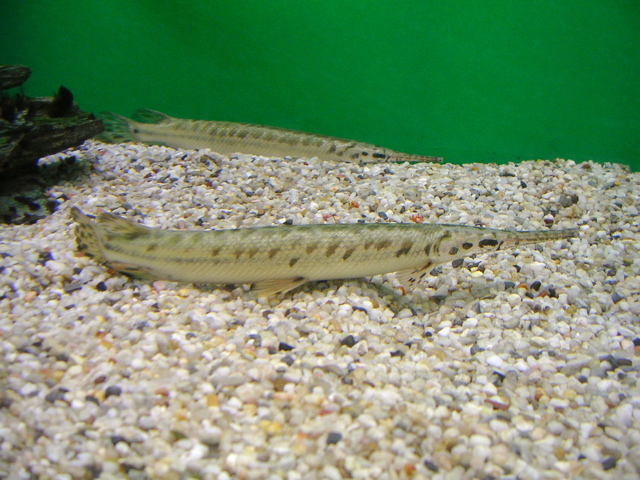
“In suitably large aquaria, gar mix quite well with Central American
cichlids, though they will view the smaller species as food”
Tank size
Central American cichlids need a lot of space. Tanks less than 110
litres (30 gallons) in size are best reserved for singletons or breeding
pairs. Collections of the smaller, milder species could be maintained in
tanks 200 litres (55 gallons) in size, but for best results you should
aim for a tank 375-750 litres (100-200 gallons) in size. This will
provide your fish with plenty of space, and make it easier to keep the
bigger and more aggressive species without them killing each other.
Taxonomy
The taxonomy of Central American cichlids is a nightmare! Until fairly
recently, most species were lumped in the one genus Cichlasoma,
a name you’ll see widely used in many older aquarium books. Since that
times there has been much sorting and segregation as species have been
moved into more narrowly defined genera based on evolutionary
relationships.
A good example is the Convict cichlid. For long known as Cichlasoma
nigrofasciatum, this species has subsequently been called Heros
nigrofasciatus, Cryptoheros nigrofasciatus and
Archocentrus nigrofasciatus, and is currently referred to as
Amatitlania nigrofasciata.
Even more dramatically, where once the Convict was recognised as a
single morphologically variable species, there are now no fewer than
four different Convict cichlid species! These is the standard issue
Convict Amatitlania nigrofasciata from the northern part of
Central America, and then three additional species native to the
southern part of the area, Amatitlania coatepeque,
Amatitlania kanna, and Amatitlania siquia. Telling these
four species apart isn’t easy, and the farmed stock sold in most
aquarium shops are likely to be hybrids anyway. Only exceptionally do
pure-bred single-species Convicts get offered for sale, as in the case
of the Honduran Red Point
Convict, a species believed to be Amatitlania siquia.
Closely related Central American species frequently hybridise. Just as
with Malawian cichlids, it makes sense to keep just one genus per tank,
i.e., one Amphilophus species, one Nandopsis species,
one Parachromis species, and so on. Any fry produced in your
tank will be much less likely to be hybrids, and this will make it
easier to sell on any surplus fish.
Amatitlania - Convict cichlids
The standard Convict cichlid of the hobby is Amatitlania
nigrofasciata. Various colour morphs are available, including an
albino form. Wild-type fish are basically grey with black vertical
bands. Females also have bright gold markings on the belly and on the
dorsal and anal fins. The species is also sexually dimorphic in terms of
size, with females being smaller at up to 10 cm (4 inches) noticeably
smaller than the males, who get up to about 12.5 cm (5 inches) in
length.
Convicts are pugnacious, and noted for their ability to coexist
successfully alongside much larger fish. They tend to bully the mild
Central American cichlids, but in sufficiently large aquaria will work
well with the more territorial, small and medium-sized species. They are
omnivores and consume both meaty and green foods.
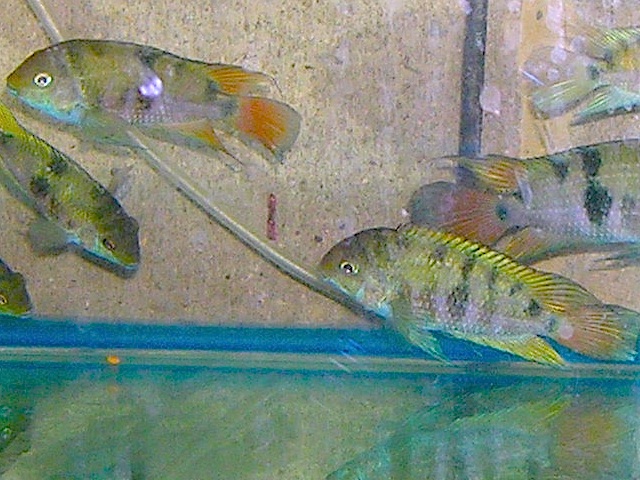
“The colourful and relatively peaceful Convict traded as the Honduras
Red Spot is a likely Amatitlania siquia”
The Honduran Red Point Convict, probably Amatitlania siquia, is
similar to the standard Convict but is smaller and has distinctive red
and green colouration in the fins. Maintenance is much like the standard
Convict, but this species appears to be somewhat less aggressive.
Amphilophus - Red Devil and Midas
cichlids
There are over twenty species described for this genus, though only two
are routinely traded. These are the Midas cichlid Amphilophus
citrinellus and the Red Devil Amphilophus labiatus. Both
species are predominantly greenish-grey to brown in the wild, but
aquarium fish are almost exclusively of the xanthomorphic forms that
exhibit strong yellow, orange or red colouration.
Distinguishing between the two species isn’t necessarily easy, although
in theory Amphilophus labiatus should have thicker lips and a
smaller nuchal (on males) than Amphilophus citrinellus.
Unfortunately for the aquarist, Amphilophus labiatus specimens
rarely develop their thick lips in captivity, and the relative
proportions of the nuchal hump will only be apparent on old males and is
obviously of no use for sexing females! In terms of colour,
Amphilophus labiatus tends to have a more intense red-orange
colour, whereas Amphilophus citrinellus are usually orange to
yellow-white instead.
Both species are big, getting to at least 20 cm (8 inches) in captivity.
They are aggressive, and should only be combined with the most robust
cichlids and catfish. They are omnivores that will consume both plant
and animal foods. Snails are a particularly important part of their diet
in the wild.
Archocentrus - Mild Mannered Rainbows
At least three species belong to this genus, but only one species, the
Rainbow cichlid Archocentrus multispinosus, is commonly traded.
It works well in community tanks, and is probably the best Central
American cichlids for beginners. As its name suggests, this species
varies its colours with its mood. The body is generally yellow to brick
red, but becomes very dark, almost black, when spawning.
Archocentrus are omnivores, and offerings of both crustaceans
and green foods will help them develop their best colours.
Cichlasoma - Salvinii and Mojarra
cichlids
Ichthyologists continue to debate what does and doesn’t belong in the
genus Cichlasoma, with almost forty species remaining in a
genus that spans the rivers and lakes of both Central and South America.
Consequently it is difficult to make any useful generalisations except
to say that these fish tend to be medium-sized omnivores and are usually
pretty aggressive. Sexual dimorphism tends to be slight, and the only
reliable way to sex these fish is to examine the genital papillae.
Otherwise, you can rear juveniles in groups and allow them to pair off
naturally.
The two species most commonly traded are the Salvinii and the Mojarra.
The Salvinii cichlid Cichlasoma salvini is of moderate size,
getting to about 15 cm (6 inches) in length under aquarium conditions,
males being a little bigger than females. Both sexes can be brilliantly
coloured, especially when spawning. The body is lemon yellow and bears
two black bands on the upper part of the flank, each black band lined
with blue scales. The black bands are most obvious during spawning, and
may fade away completely at other times. An orange-red patch spans the
lower flank between the pelvic fins and the tail fin; this is most
obvious on the females, and may be absent from males altogether. Colours
vary dramatically with mood, and the youngsters usually seen on sale are
not particularly eye-catching. There is some variation in the wild as
well, with fish from different places having slightly different colours.
Cichlasoma salvini is an aggressive, territorial species also noted
for being an accomplished piscivore, though its usual diet in the wild
is mainly plant material and benthic invertebrates of various types. It
tends to avoid interacting with larger cichlid species, and ignores
schooling midwater fish too large to eat.

“Like most Central American cichlids,
Cichlasoma salvinii are omnivorous in the wild, feeding primarily
on invertebrates and plant material”
The Mojarra or Mayan cichlid Cichlasoma urophthalmus is a big
species at up to 40 cm (16 inches) in length. It is one of the species
most strongly associated with brackish water conditions, and wild fish
show a distinct preference for coastal lagoons. Under aquarium
conditions it does not need to be kept in brackish water. It is
aggressive, and should be kept alone or with equally robust species,
though care should be taken to avoid species too similar in shape or
colouration, as such fish will tend to bring out its worst behaviour.
Its sheer size demands a massive aquarium: singletons won’t tolerant
other cichlids in anything under 375 litres (100 gallons) and breeding
pairs will need a tank twice that size if you want to avoid carnage!
The Mojarra is often confused with a South American cichlid
Cichlasoma festae. When the two are compared, Cichlasoma festae
has a smaller eyespot on the tail fin but more intense red colouration.
Herichthys - Texas cichlids
There are at least ten species in the genus Herichthys but only
two are normally traded. Historically there has been much confusion
between these two species, Herichthys carpintis and
Herichthys cyanoguttatus, with both fish being known as Texas
cichlids. In fact only Herichthys cyanoguttatus is naturally
found in Texas, specifically the Rio Grande, as well as Mexico.
Telling the two species apart is difficult, but in general
Herichthys cyanoguttatus is covered with much smaller blue-white
spots than Herichthys carpintis. Body colour in both cases can
vary dramatically with mood, though it is typically some shade of blue,
often with dark vertical bands.
Herichthys are omnivores that consume some plant matter alongside
small crustaceans, worms and insects. They are reasonably well behaved
fish in communities alongside other robust cichlids, but do become
extremely aggressive when spawning.
Hypsophrys - Nicaragua cichlids and
the Poor Man’s Tropheus
Hypsophrys species are mostly rheophilic fish, meaning that it is
adapted to fast-flowing shallow water habitats. Consequently they
appreciates water with a decent water current and plenty of oxygen.
Hypsophrys nicaraguensis is a relatively big species, with males
reaching as much as 25 cm (10 inches) in the wild, though under 20 cm (8
inches) is more typical under aquarium conditions. Females are a bit
smaller. Despite their size, these are comparatively peaceful fish. They
would do well alongside midwater fish adapted to a similar habitat, for
example large Danio or Barilius species. Quality
specimens have amazing colours, metallic red and yellow around the belly
blending to blue-green on the flanks, with prominent black spots and
banding on the flanks. The eye is bright gold, and the fins are marked
with gold, red, black and turquoise blue. Hypsophrys nicaraguensis
is an omnivore with a taste for aquatic plants.
Hypsophrys nematopus is an odd little cichlid that looks for all
the world like an East African Tropheus of some kind! At one
point known as Neetroplus nematopus, many aquarists still refer
to them as Neets. Basic care is much like Hypsophrys nicaraguensis
in terms of water conditions and diet, but they are much smaller, at
about 12 cm (4 inches) or so in length, the males a bit bigger than the
females. Despite being fairly small herbivores, these fish are
remarkably aggressive, and are best kept in their own tank. In community
systems they tend to either terrorise fish of similar size, or else end
up getting bullied (or eaten) by any substantially larger cichlids.
Nandopsis - Biajaca
While quite a few species have been included in this genus at one time
or another, currently only three species are placed here, and none of
them are much traded as aquarium fish. The Cuban cichlid Nandopsis
tetracanthus is sometimes seen, and it is smart-looking fish in its
way, with bright silver-gold scales on a dark blue-black body It is
territorial but not especially aggressive, so could be considered for a
robust community of medium-sized Central American cichlids and catfish.
Parachromis - Guapote cichlids
The guapote cichlids are the large, carnivorous species that tend to be
fairly to very aggressive. While often spectacular fish, their size and
temperament excludes them from all but the biggest aquaria. Oddly enough
they tend to tolerate dissimilar fish (such as Amphilophus
species) rather well, provided they have space, but are invariably
hostile towards one another or any other Parachromis species
kept with them. It probably goes without saying that mated pairs will
dominate any tank, so unless you have a gigantic aquarium, these fish
are best kept as singletons.
Several species are traded, including Parachromis dovii,
Parachromis friedrichsthalii and the popular Jaguar cichlid
Parachromis managuensis. At more than 30 cm (12 inches) in length
Parachromis managuensis is a definite tank-buster, but it is a
beautiful fish with a gorgeous pattern of black spots against a silver
or gold body. It is carnivorous, but accepts pellets without complaint,
though it enjoys earthworms, river shrimps and chopped seafood, and
offerings of small frozen fish such as lancefish are welcomed as well.
Petenia - Bay Snook
A single species is included in this genus, and at up to 50 cm (20
inches) in length it really has no value as an aquarium fish, despite
the fact it isn’t especially aggressive. It is an out-and-out predator
with a huge mouth, and adult fish at least feed primarily on smaller
fish, including other cichlids.
Rocio - Jack Dempseys
At least two types of Rocio are on sale, the standard dark blue
Jack Dempsey Rocio octofasciata and the brilliant Electric Blue
Dempsey that is said to be particular variety of Rocio octofasciata
bred in captivity. Some aquarists believe it to be a hybrid, but there’s
little hard evidence to support that theory. In any case, both fish are
maintained in the same way.
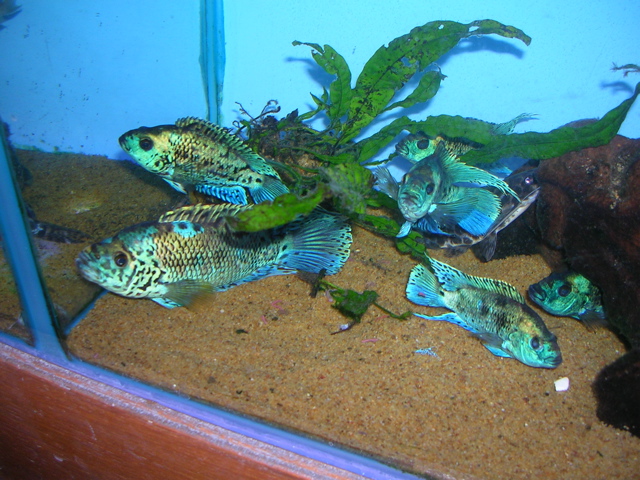
“There’s some debate over the origins
of the Electric Blue Jack Dempsey, though it is currently assumed to be
a selected form of Rocio octofasciata”
These are medium-sized cichlids at up to 20 cm (8 inches) in length
though often rather less. They are omnivores, with wild fish consuming
both plants and animal foods, particularly algae and insect larvae. They
are notoriously aggressive at breeding time, but by the standards of
Central American cichlids generally, not especially aggressive the rest
of the time. They work well in communities of robust cichlids, given
sufficient space and hiding places.
Thorichthys - Firemouth cichlids
The eight species included in this genus are of moderate size, typically
around 15 cm (6 inches) or so and noted for their rather specialised
mouthparts. They are earth-sifters that feed extensively on algae and
invertebrates sifted out from the sediment. While pretty adaptable in
captivity, their delicate jaws put them at a disadvantage when kept with
more aggressive cichlids: should they get caught up in a fight, their
jaws are easily dislocated. Even cichlids as small as Convicts are
liable to damage them. So these cichlids are best kept on their own or
in a suitably configured community with schooling midwater fish such as
Mexican tetras or swordtails.
By far the most commonly traded species is Thorichthys meeki,
generally known as the Firemouth on account of its bright red throat.
Instead of fighting in the normal way, these cichlids threaten one
another by inflating their throats, exposing more of the red colouration
and flaring the blue eyespots on their gill covers. Essentially a gentle
giant when given space and kept away from other benthic cichlids, it
does become much more aggressive when spawning, and doesn’t quite make
the grade as a standard community fish. But as a Central American
cichlid from the beginner, this species has much to recommend it, not
least of all its wide availability and overall hardiness.

“Thorichthys ellioti isn’t
widely traded, but it makes an interesting alternative to the standard
Firemouth cichlid”
Occasionally you will see other species on sale, such as Thorichthys
ellioti. Apart from differences in colouration, these are
essentially similar to the Firemouth in terms of care. Thorichthys
ellioti in particular is very vividly coloured with bright blue
spots over its body.
| Neotropical Cichlids
on WWM
Related Articles:
Neotropical Cichlids,
African Cichlids,
Dwarf
South American Cichlids,
Cichlid Fishes
in General,
Related FAQs:
Neotropical Cichlids 1,
Neotropical Cichlids 2,
Neotropical Cichlids 3,
Neotropical Cichlid Identification,
Neotropical Cichlid Behavior,
Neotropical Cichlid Compatibility,
Neotropical Cichlid Selection,
Neotropical Cichlid Systems,
Neotropical Cichlid Feeding,
Neotropical Cichlid Disease,
Neotropical Cichlid Reproduction,
Convicts,
Oscars,
Firemouths,
Texas
Cichlids,
Severums,
Triangle
Cichlids, &
Cichlids of the World,
Cichlid
Systems,
Cichlid
Identification,
Cichlid
Behavior,
Cichlid Compatibility,
Cichlid
Selection,
Cichlid
Feeding,
Cichlid
Disease, Cichlid
Reproduction,
|
|
|
|
|
|
